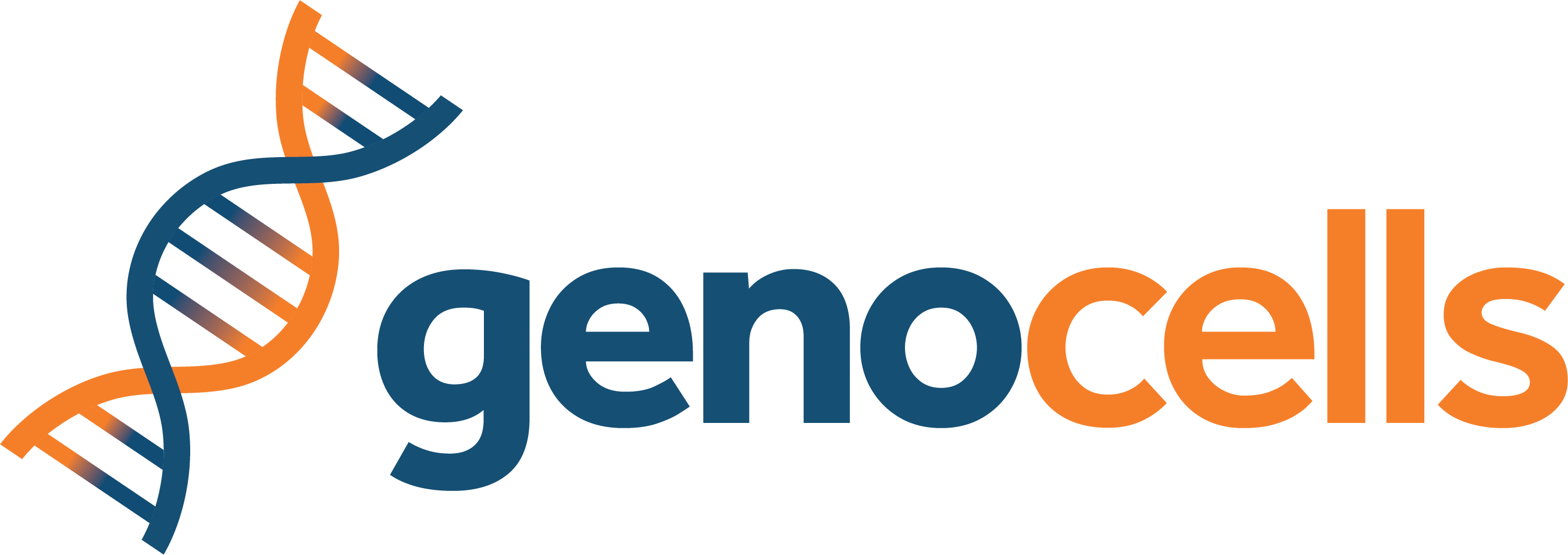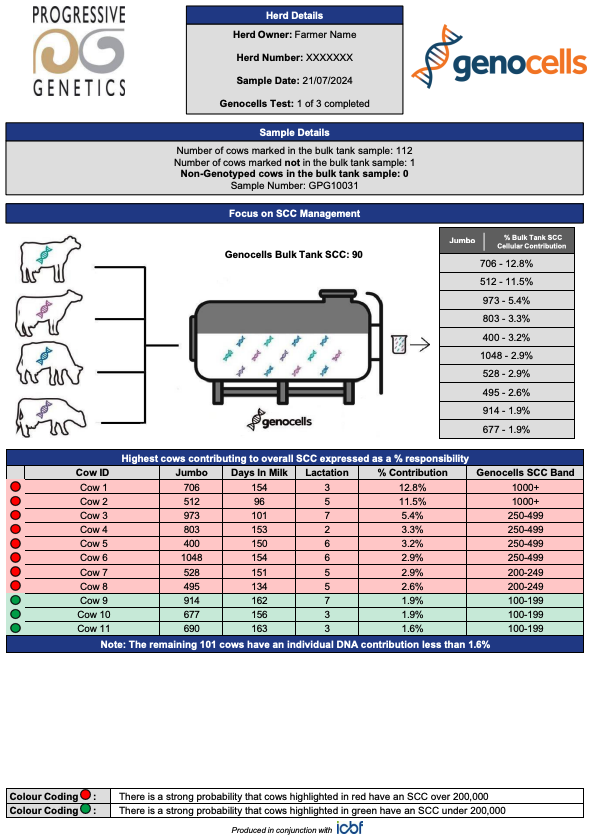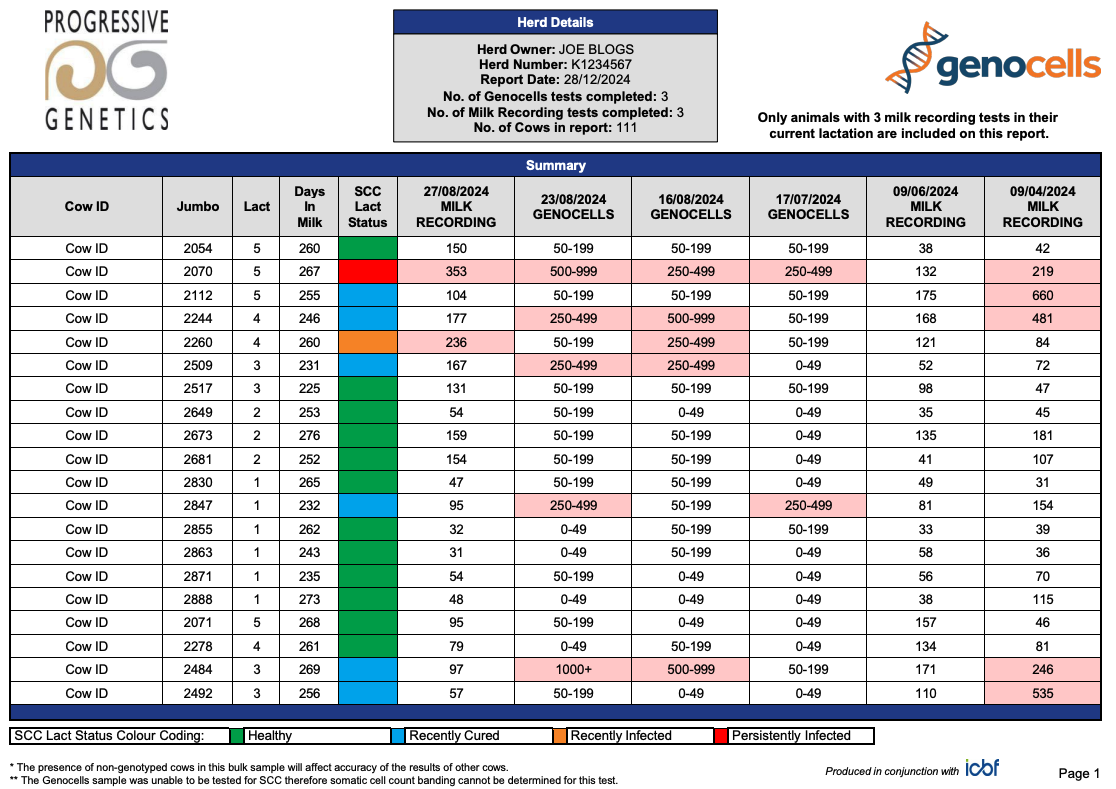
GenoCells is a revolutionary technology that allows us to identify the highest contributors to bulk tank SCC by genotyping a single bulk tank milk sample.
What are the benefits of GenCells?
- GenoCells is suited to those that require extra SCC surveillance at different time points throughout the lactation to facilitate more effective bulk tank SCC management.
- GenoCells is a quick, low effort method of identifying high contributing cows from a single bulk tank sample.
- GenoCells can only be used in conjunction with milk recording SCC results to give more points of information throughout the lactation for minimal effort and is less disruptive to the milking process.
- This will allow more informed decisions to be made to control and manage SCC both during the lactation and at the end of lactation when choices are being made for the dry period.
- After 4 milk recordings are complete GenoCell and milk recording results are combined for categorisation which leads to easy interpretation of results.
What must I do to take part in Genocells?
The requirements
- All cows must be Genotyped prior to participating in the GenoCells programme. Please note samples that include cows that were not genotyped at the time the bulk tank sample was taken will affect the accuracy of the results of the other cows
- The herd must be signed up to complete 4 milk recordings in the calendar year.
- At least one milk recording must be completed before a GenoCell test can take place.
- Once all cows are Genotyped contact Progressive Genetics milk recording department indicating the number of GenoCells tests you intend to do. A permission form allowing Progressive Genetics access to the herds Genotype results will need to be completed and returned to the office.
- The bottles, an instruction sheet for taking samples and a stamped addressed swift post envelopes will be posted to the herdowner.
- The ICBF Herdplus App will also need to be downloaded there is no cost associated with this. The app is required to Upload the sample details prior to testing.

How to take a Genocells sample
- Herd Details
- Herd Owner Name
- Herd Number
- Sample Date
- Report Date
- Genocell Test: 1 of 3 completed (no of completed tests including the current test as a proportion of the number of tests scheduled)
- Sample Details
- Number of cows marked in the bulk tank sample. (from the APP)
- Number of cows marked not in the bulk tank sample. (from the APP)
- Number of Non-Genotyped Cows in bulk tank Sample (from the App)
- Bulk Tank SCC result (from Weatherby’s)
- Bar Code Sample Number (from the app & Wetherby’s)
- Where there are non-genotyped cows marked in the app as being in the tank the following message will be highlighted in bold. “Please Note: The presence of non-genotyped cows in the bulk sample will affect accuracy of the results of other cows.”
- Cow Information (Bulk Tank Schematic)
- Diagram to be included showing the cow no and the % cellular responsibility for the top 10 cows.
- Cow Information (Table Format)
- Tag Number
- Jumbo Number
- Lactation Number
- Days in Milk
- % Cellular Responsibility: Once the genotype of the tank is known, statistical analysis determines the cellular responsibility of each cow in the tank. The cows are listed in order of cellular responsibility with the cows at the top of the list having the highest cellular responsibility.
- Colour Coding: There is a strong probability that cows highlighted in red have an SCC over 200,000 and cows highlighted in green have an SCC under 200,000

- Milk Recording / GenoCell Summary Report – After 4 Milk RecordingsFor herds less than 200 cows the summary report will list all cows currently in the herd that were tested in the period.Due to the increased mix of DNA in samples from herds with greater than 200 cows we can only reliably report results from cows that appeared on the test day report and are still in the herd.
The Milk Recording / Genocell Summary Report contains the following information:
- Tag Number
- Jumbo Number
- Lactation Number
- Days in Milk
- The GenoCell and milk recording results are shown separately.
- The tests are in date order from left to right across the page. If there is insufficient room on the page the oldest test(s) are not shown. But all tests in the lactation are used for categorization.
- The % Cellular Responsibility and the SCC band for each cow for each test will be displayed on the report.
- The SCC bands are as follows 0-99, 100-199, 200-249, 250-499, 500-999, 1,000-4999, 5,000+
- If a cow is not present or has no milk recording SCC result N/A will appear in the column for that test.
- The cows’ SCC lactation to date indicates their categorization both GenoCell and Milk Recording SCC results are used for categorization.
- Columns with tests that contain ungenotyped cows need to be highlighted in bold a message at the top of the Column stating “contained ungenotyped cows”. Where there are ungenotyped cows in any test the following message needs to be displayed on the report. Please Note: The presence of non-genotyped cows in the bulk sample will affect accuracy of the results of other cows in that test”
- Please Note: The milk recording reports do not use GenoCells results for SCC categorization.

Frequently Asked Questions
If I don't exclude the non-genotyped cows from the tank, is the result still valid?
No, as the non-genotyped cows will affect the accuracy of the results of the other cows.
Can I change the number of standard Milk Recordings now that I'm starting Genocells?
The objective of this service is not to reduce the number of standard milk recordings but rather to give additional insights at different time points throughout the year. A minimum of 4 milk recordings are required.
What happens if herdowner has more than 1 milkings in the tank?
The test is invalid.
What happens if I forget to input cow information on the test day into the app?
The sample will be tested but there will be a significant delay for the herdowner receiving the results. Office personnel will need to contact the herdowner to update the app to establish cows not in the tank for the milking that the sample was taken from.
Can I send a sample in a bottle other than the one I received in the post from Progressive Genetics?
No, the lab will only be able to test samples in bottles that are bar coded and associated to a herd prior to posting.
What happens if I don’t complete 4 milk recordings?
The Genocells summary report is only available after 4 milk recordings are completed.
Why is it necessary to agitate the bulk tank before taking a sample?
It is important that the bulk tank is agitated so that a representative DNA sample is collected. If the sample is not representative, this will fundamentally affect the reliability of the results.
Why do I need to declare the cows contributing milk to the bulk tank?
To maximise the accuracy of the cellular responsibility, it is essential that cows contributing to the bulk tank are identified correctly. If cows are not properly identified, cellular responsibility may be falsely attributed to close relatives.
If the calving date is not registered, can this cow be included in the Genocells sample?
Yes, however the cow will not automatically be selected on the app and will need to be added by the herdowner.
If I buy in a cow and she is not yet moved into my herd, can she be included in the Genocells sample?
Yes, the cows full tag number will need to be added through the app if she is to be included in the Genocells bulk sample.
If I am milking cows on more than one platform how will this work with Genocells?
It is essential that cows contributing to the bulk tank are identified correctly. For all herd numbers, cows with a registered calving date are automatically selected on the app as being in the bulk tank. In situations where the cows registered in a herd number are being milked into more than one bulk tank, all cows not milked into the bulk tank from which the Genocells sample is taken need to be deselected on the app.
Why is the service only available to milk recording customers? Why is it not available to everybody through the co-op?
Milk recording is essential as Genocells uses yield to calculate SCC. Genocells cannot calculate fat and protein percentages. After 4 milk recordings are complete, GenoCells and milk recording results are combined for categorisation which leads to easy interpretation of results.
If I am milk recording already, what additional benefits can I gain from doing Genocells?
Genocells is a simple and convenient means of receiving additional points of information throughout the lactation allowing for more effective SCC management. Genocells offers herd owners the opportunity to receive additional points of information in between milk recordings with minimal effort to enable continuous surveillance.
Can the turnaround time be improved from 7 days?
Currently the turnaround is approximately 7 days. It is not envisaged that for 2025 a shorter turnaround time will be achieved.
Can you get fat and protein from Genocells and just record yield from milk recording?
Greater than 98% of somatic cells in milk are white blood cells. White blood cells are part of the immune system and so these cells increase in number in response to mastitis causing pathogens. Somatic cells are the only milk components that contain DNA. Milk fat and protein do not contain DNA, therefore Genocells cannot be used to measure these components.
Is it possible to use Genocells on its own without Milk Recording?
A cow’s yield is an essential component of the Genocells calculation for SCC. Without yield, SCC bands cannot be measured. So, in order to be able to avail of our Genocells service, Progressive Genetics stipulate that at least one milk recording is completed before starting Genocells and the herd must be signed up for at least four milk recordings.
I have a low SCC herd, and I am managing SCC with milk recording so why do I need Genocells?
If your herd experiences a spike in cell count, Genocells is a simple and convenient way of identifying those high SCC cows relatively quickly with minimal effort. Genocells offers additional points of information at particular time points which may be of benefit to herdowners depending on what they are focusing on at any given time.
Is Genocells accurate?
Trials have shown a very high correlation between SCC measured using Genocells and SCC measured from milk recording, in herds up to 500 animals.
How many times in a year can I do a Genocells test?
You can complete a Genocells test as many times as you choose during the year.


